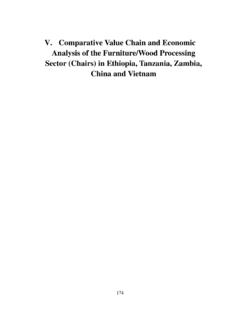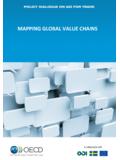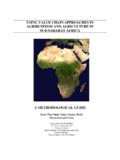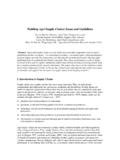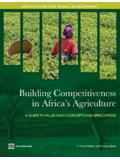Transcription of END MARKET ANALYSIS OF ETHIOPIAN LIVESTOCK ... - …
1 END MARKET ANALYSIS OF. ETHIOPIAN LIVESTOCK AND MEAT. A DESK STUDY. microREPORT #164. MAY 2010. This publication was prepared by Elisabeth Farmer, ACDI/VOCA Consultant, with support from the Accelerated Microenterprise Advancement Project (AMAP), funded by USAID. End MARKET ANALYSIS of ETHIOPIAN LIVESTOCK and Meat 1. END MARKET ANALYSIS OF. ETHIOPIAN LIVESTOCK AND MEAT. A DESK STUDY. microREPORT #164. DISCLAIMER. The author's views expressed in this publication do not necessarily reflect the views of the United States Agency for International Development or the United States Government. CONTENTS. EXECUTIVE SUMMARY .. 1. I. CONTEXT .. 2. II. CHANNELS .. 8. III. CUSTOMERS .. 18. IV. 29. V. CHOICES .. 38. RECOMMENDATIONS FOR FURTHER DATA COLLECTION AND ANALYSIS .. 39. BIBLIOGRAPHY .. 42. ANNEXES .. 45. TABLES AND FIGURES. Table 1. Feedstuffs Price Evolution 2003 to 7. Table 2: Major Cattle and Beef Importers, 2007, and Recent Trends (2005-2007) .. 20. Table 3: Major Sheep and Sheep Meat Importers, 2007, and Recent Trends (2005-2007).
2 21. Table 4: Major Goat and Goat Meat Importers, 2007, and Recent Trends (2005-2007) .. 22. Table 5: 2008 Exports to Middle Eastern Markets .. 32. Table 6: Grid ANALYSIS of Current or Potential Markets .. 38. Figure 1: MARKET Map of ETHIOPIAN LIVESTOCK and Meat .. 8. Figure 2: ETHIOPIAN Live Animal and Meat Exports, 1971-2008 .. 30. ACRONYMS. APEDA Agricultural and Processed Food Products Export Development Authority BSE Bovine Spongiform Encephalopathy (Mad Cow Disease). CAD Cash Against Document CBPP Contagious Bovine Pleuropneumonia CCPP Contagious Caprine Pleuropneumonia EMBRAPA Brazilian Agricultural Research Corporation ETB ETHIOPIAN birr FAO Food and Agriculture Organization FAS Foreign Agricultural Service FMD Foot and Mouth Disease GCC Gulf Cooperation Council GFDRE Government of the Federal Democratic Republic of Ethiopia HACCP Hazards ANALYSIS and Critical Control Point KSA Kingdom of Saudi Arabia LC Letter of Credit LMA LIVESTOCK Marketing Authority MLA Meat and LIVESTOCK Australia MOARD Ministry of Agriculture and Rural Development MT Metric Ton OIE World Animal Health Organization RVF Rift Valley Fever SPS Sanitary and Phytosanitary SPS-LMM Sanitary and Phytosanitary LIVESTOCK and Meat Marketing TAES Texas Agricultural Experiment Station UAE United Arab Emirates USD United States Dollar USDA United States Department of Agriculture END MARKET ANALYSIS OF ETHIOPIAN LIVESTOCK AND MEAT i AUTHOR'S NOTE.
3 This end MARKET ANALYSIS of ETHIOPIAN LIVESTOCK and meat was originally intended to include on-the-ground interviews and other primary research. However, as significant recent data was available in trade mission reports, industry websites, trade databases and various studies, it was agreed that an initial end MARKET study be drafted as a desk study, using the available data from secondary sources. The present document is the result of that study. The author made efforts to consult a variety of sources, obtain the most relevant and up-to-date information, and corroborate the findings of this paper with informants on the ground. Trade mission reports and other useful documents from the Sanitary and Phytosanitary- LIVESTOCK and Meat Marketing (SPS-LMM) Program and data from FAOSTAT and UN- COMTRADE proved particularly useful, together with reports and studies from a variety of sources. The absolute reliability of every figure reported in these trade databases cannot be verified nevertheless, in the absence of a thorough MARKET monitoring system, it provides the most useful comparative overview of trade data that is currently available.
4 There are, however, inevitable gaps in data, as information on certain recent developments in the LIVESTOCK sector (for instance, the impact of the opening of quarantine stations in the Somali ports of Berbera and Bosasso) were not available to the author at the time of writing. Due to these gaps, some of the standard elements of the USAID Value Chain End MARKET Toolkit ( ), such as the Boston Matrix, were not included. The author's recommendations for further ANALYSIS can be found at the end of this report. It should also be noted that FAOSTAT was used for import data reported in Chapter 3, while UN-COMTRADE was used for export data reported in Chapter 4. This is simply due to the fact that the author used the FAOSTAT database at the beginning of the study, as this source seemed more common in studies and reports. It later became apparent that UN-COMTRADE had more detailed data ( boneless meat vs. carcasses and bone-in cuts, etc.), and the author therefore switched to UN-COMTRADE in order to include a more detailed ANALYSIS in Chapter 4.
5 Finally, and most importantly, the author is grateful to the knowledgeable individuals who reviewed the report and provided invaluable comments and insights, including Hank Fitzhugh and Belachew Hurrissa (TAES/SPS-LMM), Yacob Aklilu (Tufts University), Mohamed Abdinoor (USAID/Ethiopia) and Jim Yazman (USAID/EGAT). Their feedback was extremely helpful in updating and deepening the author's knowledge of the ETHIOPIAN LIVESTOCK sector. This end MARKET ANALYSIS is far stronger for their input. - Elisabeth Farmer, consultant for ACDI/VOCA. END MARKET ANALYSIS OF ETHIOPIAN LIVESTOCK AND MEAT ii EXECUTIVE SUMMARY. Ethiopia has some important comparative advantages in the Middle Eastern LIVESTOCK and meat markets. The meat characteristics of Ethiopia's lowland breeds particularly Boran bulls and Somali Blackhead sheep are prized by consumers. Geographical proximity to Egypt and the Gulf makes both live animal exports and chilled meat exports possible. Live animal exports are high, as an estimated million livestock1 are exported from the country annually.
6 Although the vast majority of these (approximately million) pass through informal channels. These LIVESTOCK exports have suffered from repeated trade bans due to importing countries' concerns over transboundary diseases. Yet the solution to these bans quarantine stations in Djibouti and now in other port cities as well has proved to have its own drawbacks, with high costs and concerns over growing foreign influence within the ETHIOPIAN LIVESTOCK trade. In order to overcome these challenges and increase in-country value addition, the ETHIOPIAN Government is committed to supporting meat exports. Yet such exports remain small in volume, constrained by inefficiencies in purchasing, poor animal handling and inadequate facilities at the abattoir and export level. These factors all contribute to low meat quality and unreliable supply which are the major complaints of Gulf importers regarding ETHIOPIAN meat. In addition to these internal challenges, ETHIOPIAN LIVESTOCK and meat exporters face stiff competition from Brazil, India, Pakistan, Australia and New Zealand.
7 Brazilian beef is price competitive as a result of low production costs, while India has a ready-made MARKET , catering primarily to the large non-resident Indian population in the Gulf for its beef (buffalo meat) exports. Australia, which exports primarily sheep meat to the Middle East, has an aggressive marketing campaign through its regional marketing office and targets the higher end of the MARKET . Faced with such competitors, ETHIOPIAN meat exporters find it difficult to compete on price or quality. This document analyzes the context, channels, customers and competitors for ETHIOPIAN live animals and meat. Based on these four factors, an initial shaded grid ANALYSIS on potential markets shows the UAE, Saudi Arabia, Yemen and Egypt as the most promising target markets for ETHIOPIAN LIVESTOCK and meat. However, this ANALYSIS is only the first step, and must be followed by additional on-the-ground research in order for definitive conclusions and recommendations to be made on how to best increase the competitiveness of the ETHIOPIAN LIVESTOCK sector.
8 1. Author's computation based on data from Yacob Aklilu and Catley (formal export of 200,000 head of LIVESTOCK ) and Mohammad Jabbar et al (informal export of 328,000 head of cattle and million sheep and goats). END MARKET ANALYSIS OF ETHIOPIAN LIVESTOCK AND MEAT 1. I. CONTEXT. A. POLICIES. 1. POLICIES SUPPORTING LIVESTOCK DEVELOPMENT AND PARTICULARLY MEAT EXPORTS. The Government of the Federal Democratic Republic of Ethiopia (GFDRE) recognizes LIVESTOCK as one of the country's key economic resources. The government's policy aims to increase in-country value addition by encouraging meat exports over live animal exports. In January 2010, the Ministry of Agriculture and Rural Development (MOARD) launched a request for Expressions of Interest (EOI) for the completion of the LIVESTOCK Development Master Plan. This plan initiated in 2004 but stalled at the baseline phase after the second phase was rejected was originally intended to support meat production for both the domestic and export markets and encompass technology packages for meat production, the establishment of disease-free zones and a standardized sanitary and phytosanitary (SPS) system.
9 The development of these plans has proven difficult, yet government targets for exports remain ambitious. The GFDRE's current aim is to increase meat exports from 8,000 MT to 30,000 MT2 per year 3, which given the low dressing rate of sheep and goats will require a significant increase in beef exports. Indeed, beef is expected to account for two-thirds of the overall exports. 2. EXPORT PROCEDURES AND CURRENCY REGULATIONS. Exporting cattle legally requires multiple steps. First, an export license must be obtained, which is a relatively simple process. The export process itself, however, is more lengthy and complex. The exporter must hire a transitor company to handle the bureaucratic customs clearance process. To meet the required currency regulations, the exporter must then obtain a letter of credit (LC) or cash against document (CAD), or deposit an advance payment in a bank. In the advance payment system, which is operational in the legal cross-border trade with Sudan as well as export to Somaliland, the exporter must deposit $500 (in Metema for export to Sudan) or $420 (in Togwajale for export to Somaliland) 4 per head of cattle thereby ensuring that the government earns foreign currency in order to obtain a bank permit.
10 The bank gives the exporter the ETHIOPIAN birr equivalent. In order to obtain the required dollars, exporters buy them in cross-border markets (for example, in the Sudanese MARKET ) or in the domestic black MARKET . The CAD system is also difficult, requiring a higher level of working capital than most exporters have. These requirements much like the policy supporting meat exports are a direct consequence of the GFDRE's need for hard currency and contribute to a high rate of informal exports from Ethiopia, as described later in this report. Finally, the exporter must obtain a health certificate from a quarantine service station, following a minimum of 30. days of quarantine during which the exporter is responsible for all feed and watering expenses. 5 In the past, traders were required to visit at least 12 different offices and institutions and pay fees at each office in order to process their export documents however, in the last two years the government has implemented a one-stop shop for export documents, which has greatly facilitated the process.

